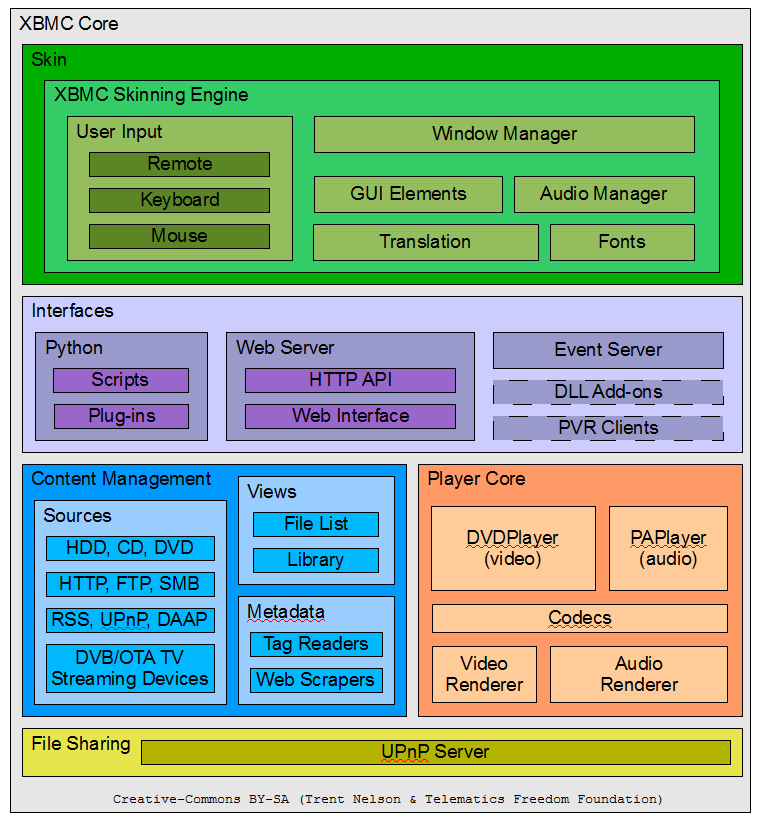|
Dreambox
Dreambox is a series of Linux-powered DVB satellite, terrestrial and cable digital television receivers (set-top boxes), produced by German multimedia vendor Dream Multimedia. History and description The Linux-based production software originally used by Dreambox was originally developed for DBox2, by the Tuxbox project. The Dbox2 was a proprietary design distributed by KirchMedia for their pay TV services. The bankruptcy of KirchMedia flooded the market with unsold boxes available for Linux enthusiasts. The Dreambox shares the basic design of the DBox2, including the Ethernet port and the PowerPC processor. Its firmware is officially user-upgradable, since it is a Linux-based computer, as opposed to third-party "patching" of alternate receivers. All units support Dream's own DreamCrypt conditional access (CA) system, with software-emulated Conditional-access module, CA Modules (CAMs) available for many alternate CA systems. The built-in Ethernet interface allows networked c ... [...More Info...] [...Related Items...] OR: [Wikipedia] [Google] [Baidu] |
DBox2
The DBox is a DVB satellite and cable digital television integrated receiver decoder (set-top box). They were distributed widely for use with Pay television channels. It was commissioned by the Kirch group's DF1, an early German provider of digital television that later merged with Premiere. The hardware was developed and produced by Nokia though later also produced by Philips and Sagem under license. The combination of third-party developers and network connectivity which facilitates card sharing, makes DBox2 (and the DBox2 based Dreambox) use particularly common among enthusiasts and those who intend to obtain services without payment. It also enables the receiver to store digital copies of DVB MPEG transport streams on networked filesystems or broadcast the streams as IPTV to VideoLAN and XBMC Media Center clients. In 2001, following the bankruptcy of Kirch Media, production of the D-box ceased. However, many devices continue to be traded second-hand (often using onl ... [...More Info...] [...Related Items...] OR: [Wikipedia] [Google] [Baidu] |
XBMC
Kodi (formerly XBMC) is a free and open-source media player software application developed by the XBMC Foundation, a non-profit technology consortium. Kodi is available for multiple operating systems and hardware platforms, with a software 10-foot user interface for use with televisions and remote controls. It allows users to play and view most streaming media, such as videos, music, podcasts, and videos from the Internet, as well as all common digital media files from local and network storage media. Kodi is a multi-platform home-theater PC (HTPC) application. It is customizable: skins can change its appearance, and plug-ins allow users to access streaming media content via online services such as Amazon Prime Instant Video, Crackle, Pandora Internet Radio, Rhapsody, Spotify, and YouTube. The later versions also have a personal video-recorder (PVR) graphical front end for receiving live television with electronic program guide (EPG) and high-definition digital video re ... [...More Info...] [...Related Items...] OR: [Wikipedia] [Google] [Baidu] |
Conditional Access
Conditional access (CA) is a term commonly used in relation to software and to digital television systems. Conditional access is that ‘just-in-time’ evaluation to ensure the person who is seeking access to content is authorized to access the content. Said another way, conditional access is a type of access management. Access is managed is by requiring certain criteria to be met before granting access to the content. In software Conditional access is a function that lets you manage people’s access to the software in question, such as email, applications, and documents. It is usually offered as SaaS (Software-as-a-Service) and deployed in organizations to keep company data safe. By setting conditions on the access to this data, the organization has more control over who accesses the data and where and in what way the information is accessed. When setting up conditional access, access can be limited to or prevented based on the policy defined by the system administrator. Fo ... [...More Info...] [...Related Items...] OR: [Wikipedia] [Google] [Baidu] |
MPEG Transport Stream
MPEG transport stream (MPEG-TS, MTS) or simply transport stream (TS) is a standard digital container format for transmission and storage of audio, video, and Program and System Information Protocol (PSIP) data. It is used in broadcast systems such as DVB, ATSC and IPTV. Transport stream specifies a container format encapsulating packetized elementary streams, with error correction and synchronization pattern features for maintaining transmission integrity when the communication channel carrying the stream is degraded. Transport streams differ from the similarly-named MPEG program stream in several important ways: program streams are designed for reasonably reliable media, such as discs (like DVDs), while transport streams are designed for less reliable transmission, namely terrestrial or satellite broadcast. Further, a transport stream may carry multiple programs. Transport stream is specified in '' MPEG-2 Part 1, Systems'', formally known as '' ISO/IEC standard ... [...More Info...] [...Related Items...] OR: [Wikipedia] [Google] [Baidu] |

